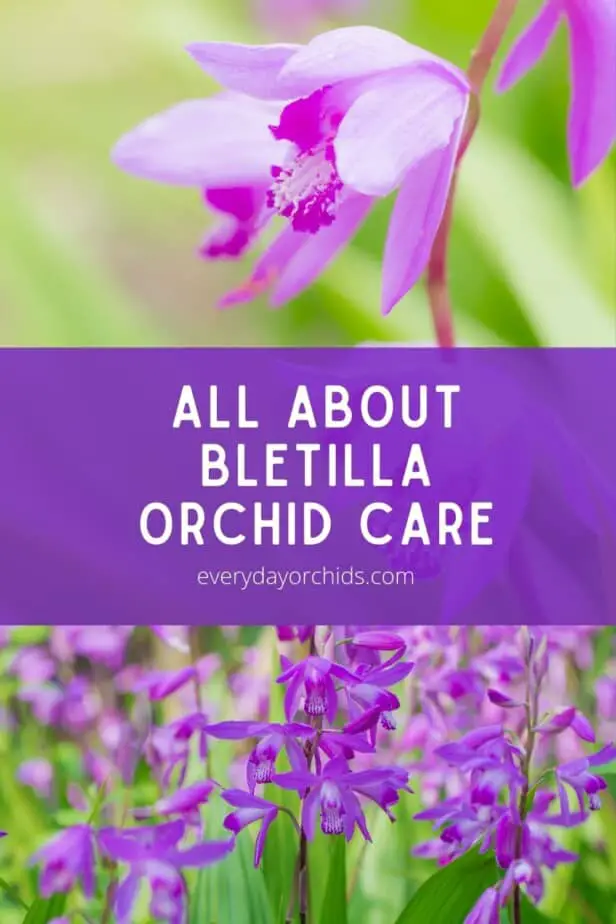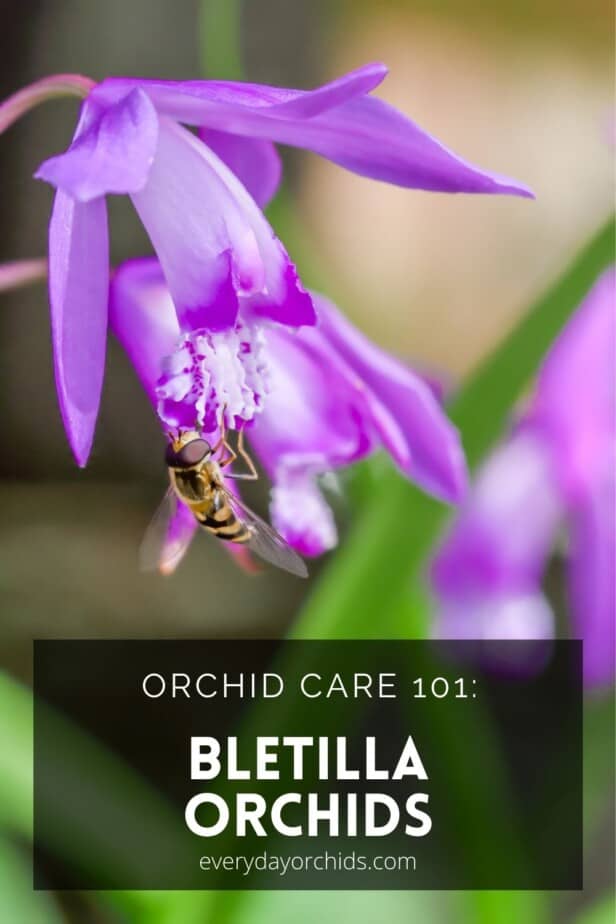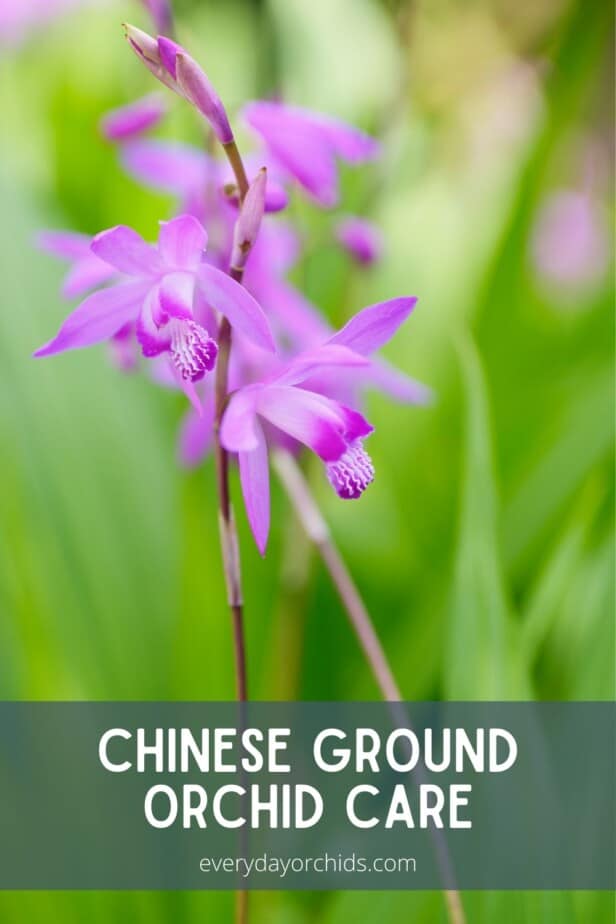Bletilla orchids, otherwise known as Chinese ground orchids, are terrestrial orchids. These lovely flowers are easy to care for and can survive low temperatures, making them a great addition to any outdoor garden.
Bletilla orchids are considered to be fairly hardy, tough, low-maintenance orchids that are great for beginners. They are often used in outdoor landscaping and garden beds. Bletilla orchids, or “Chinese ground orchids,” require partial shade, rich well-draining soil, and weekly watering during the growth season. Propagation happens through pseudobulb division. These orchids are relatively pest and disease free and can tolerate cold temperatures well.

Would you like to learn more about these orchids and how you can care for them? Look no further. I’ll go over the main points of how to care for Bletilla orchids below.
Please note that these links are affiliate links and as an Amazon Associate, I earn from qualifying purchases. Purchases made through affiliate links in this post may generate commissions at no additional cost to you. Use this link for a discounted Amazon Prime trial. Thank you for your support!
Table of Contents
What Are Bletilla Orchids?
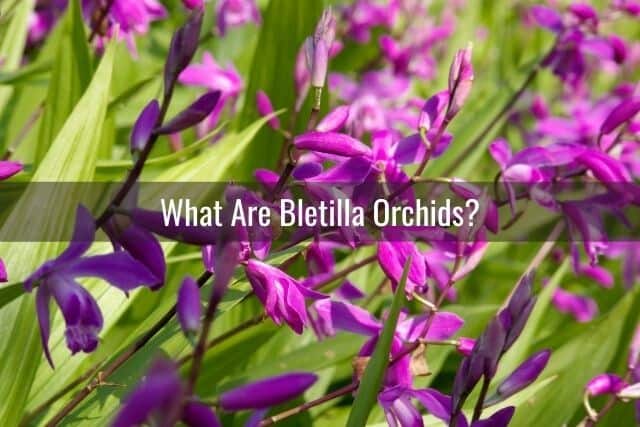
Bletilla orchids are sometimes called “Chinese ground orchids.” This is because these orchids are commonly found in China, Japan, Taiwan, and parts of Southeast Asia, including Thailand and Vietnam.
The Bletilla genus of orchids includes five distinct species. Of those five species, the Bletilla striata orchid is most commonly sold in nurseries. It is marketed as an easy-to-grow terrestrial orchid. Sometimes the label will simply say “Chinese ground orchid.” Other names for this orchid include the “urn orchid” and “Hyacinth orchid.”
Bletilla orchids are anywhere from 24 inches (2 feet) to 30 inches (2.5 feet) tall, depending on the species. These are perennial orchids, meaning they will flower year after year.
Bletilla Orchid Flowers
These orchids produce multiple blooms on each stem, with as many as fourteen flowers per flower stem. The long, wide green leaves resemble sword-shaped, iris leaves.
The blooms themselves have a ruffled lip and look like smaller versions of Cattleya blooms. Bletilla flowers are quite pretty and do not have a scent.
Blooming season occurs from late spring to mid-summer and the blooms will last for about ten weeks.
Flower colors include white, pink, pink-purple, blueish-purple, dusky rose, and yellow. This orchid grows in clumps of pseudobulbs. Temperature drops in the winter helps trigger blooming in the spring.
An established Bletilla orchid will have multiple stems of flowers. With at least a dozen flowers per stem, and multiple stems of flowers per plant, a Bletilla orchid can create quite a show-stopping display in any garden.
Temperature Tolerance and Growing Zones for Bletilla Orchids
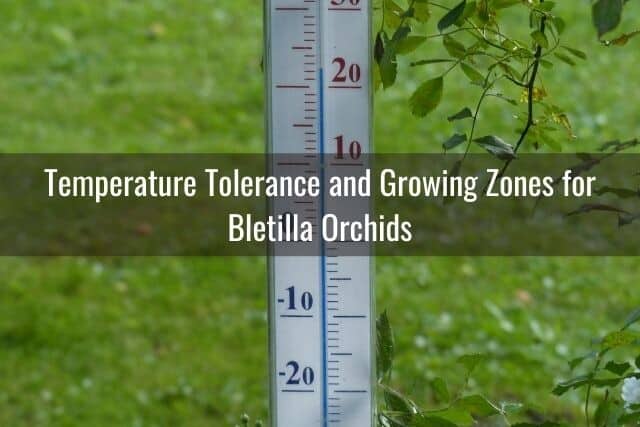
Bletilla orchids can be tolerant to cold temperatures, especially if you arrange a layer of mulch around the base of the plants once temperatures start to drop.
These orchids can grow in USDA plant zones 6 to 9 and can survive nighttime temperatures as low as -10 degrees Fahrenheit. This, of course, is provided that the orchid roots are protected with mulch and the ground does not freeze.
If you live in USDA Zone 5, you can still incorporate these terrestrial orchids into your outdoor garden. It is just a little trickier because of the danger of extremely low temperatures and freezing.
If you plan to keep them outdoors and you live in Zone 5, make sure that there is a very heavy layer of mulch covering the roots and pseudobulbs. The mulch layer can be made of leaves, pine needles, straw, or newspaper.
However, if you live in or north of USDA Planting Zone 5, a safer option would be to plant your Bletilla orchids in potted containers from the beginning. I would recommend doing this. This way, you enjoy your orchids outdoors in the spring and summer and can move them indoors or to a frost-free location in the winter.
I would suggest using planters with wheels, or wheeled plant stands, for ease of movement. Alternatively, you can plant these orchids in smaller pots that can be lifted and placed into a garden wagon when it is time to bring them indoors.
A light mulch around the potted orchids will help keep the roots warm in the winter, but is not necessary. As long as temperatures don’t drop below 25 degrees Fahrenheit, you can get away without needing to mulch the orchids in the winter.
Lighting Requirements for Bletilla Orchids
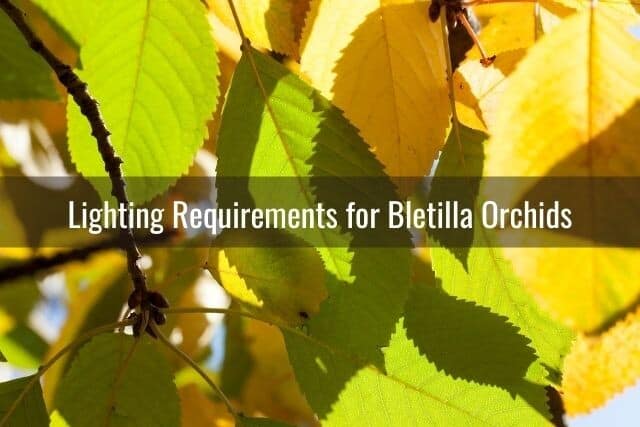
Bletilla orchids are native to the woodland areas. You can find them in the wild, growing in the dappled shade of meadows or on the edges of forests. When planting these at home, you want to provide a similar growing environment.
This means, plant your orchid in a location with partial shade, filtered light and well-drained soil. Make sure the orchid will be protected from harsh afternoon lighting, as this intense hot light can damage the leaves and burn them.
Watering Needs of Bletilla Orchids
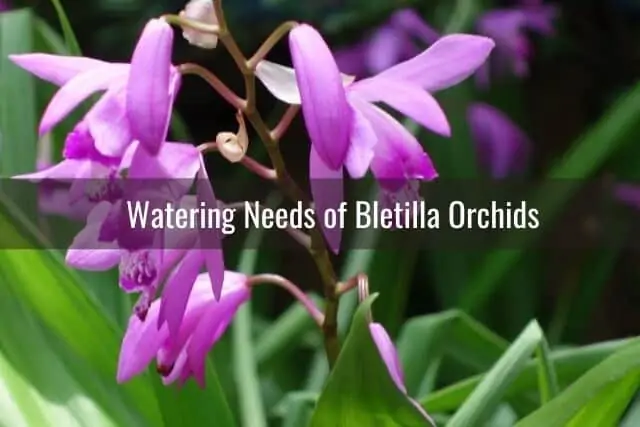
Bletilla orchids do not require frequent watering. Instead, water sparingly at the beginning of the growing season. Once new shoots start to appear, you can water your orchid once a week with a good soaking or when you notice that the potting media or soil is dry.
When the orchid is more established, you may be able to get away with watering less frequently. However, make sure the soil remains evenly moist so that the orchid doesn’t dry out during the growth season.
In the fall and winters, once the orchid becomes dormant, you do not need to water the orchid. Bletilla orchids require a cool, dry period of rest during their dormant period in the winter.
Around November and late fall, the leaves will start to drop and the plant will die down to the ground. During this time, it is fine if the soil dries out. The occasional rainfall will be enough to hydrate your plant. These orchids can survive in rain gardens and in the woods with irregular watering.
Humidity Requirements

Humidity is important for all orchids in order to grow and thrive. Bletilla orchids, in particular, prefer a humidity level between 40-60%. If you live in a location that is naturally more humid such as Asia or even Florida, maintaining outdoor humidity levels won’t be a problem.
However, if you live in a drier climate, you may need to take extra measures to increase humidity levels.
You can measure humidity levels around your Bletilla orchids using an outdoor hygrometer. If you need to increase humidity levels, you might want to do so by adding an outdoor fountain nearby, or plant them near an outdoor pond. Some people keep their Bletilla orchids in an outdoor greenhouse, so that is another option as well.
Fertilizing Your Bletilla Orchid
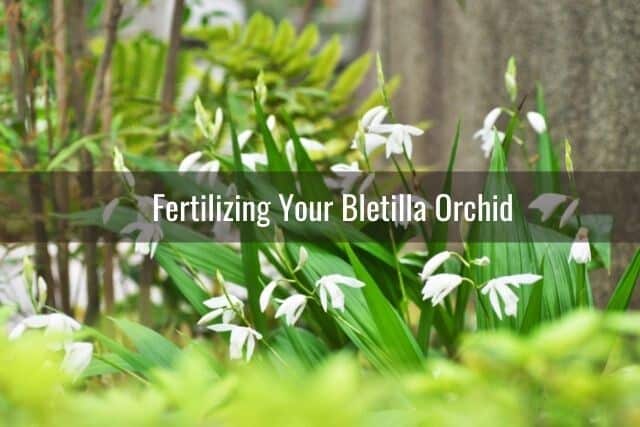
Fertilize your orchids when you first plant them, and again during the growth period. Aim to fertilize your orchids about once a month with a diluted, balanced orchid fertilizer.
A less potent fertilizer using a 10-10-10 NPK concentration would work well for these orchids. An example of this would be the Bonide liquid plant food. Just follow the product directions for dilution instructions.
Remember, unlike epiphyte orchids like the Phalaneopsis orchid, Bletilla orchids are already planted in rich, organic material. Some of their nutrition will come from the soil, so you only need to use a light orchid fertilizer to supplement its needs during the growing season.
Stop fertilizing when the orchid becomes dormant in the winter. Give your orchid a rest from both watering and fertilizing during its dormant period. Once you start seeing new growth in the spring, you can start fertilizing and watering your orchid again.
Potting Media and Soil Requirements
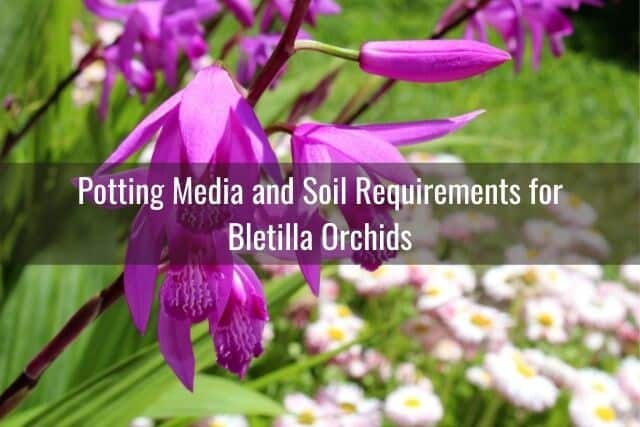
When planting your Bletilla orchids, use well-draining soil that is rich in organic material. You can use a mixture of orchid potting media, peat, and sand.
If you are planting multiple Bletilla orchids, plant them 4 inches deep and spaced at least 4 inches apart. This will give the orchids room to grow and spread out.
It is very important that the soil is well-draining and evenly moist. Make sure that the soil doesn’t remain soggy or overly wet for extended periods of time. If it does, it can lead to root rot. On the flip side, make sure the soil doesn’t dry out either, as this can lead to dried, shriveled roots and wilting leaves.
Mulching around your orchids with some leaves or straw will help prevent the orchids from frost come winter. It will also help prevent weeds from growing around your orchids and protect new growth. In hot weather, mulch will also prevent the soil from drying out too quickly between waterings.
Pruning and Transplanting Bletilla Orchids
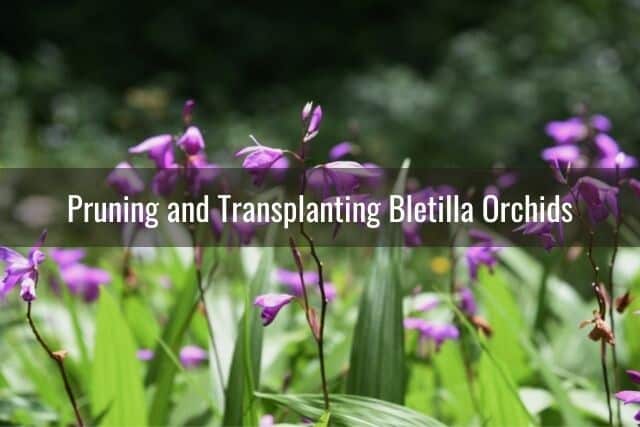
If you need to transplant your Bletilla orchid, the best time to do this would be after it is done flowering, but before it enters the dormant period. The orchid will still have leaves, but no flowers. Transplanting your orchid during flowering will cause the flowers to fall off early.
As for pruning your orchid, Bletilla orchids will need routine pruning each year, particularly when the leaves die down to the ground.
Use sterilized gardening shears to remove old, dead, brown leaves and dried up flower stalks. Removing dead foliage will help prevent pests and diseases and make way for new growth come spring.
Pests and Diseases
Bletilla orchids are hardy orchids. The good news is that not many pests or diseases affect these outdoor orchids. That said, there are still a few pests that can infest these plants. In particular, watch out for aphids, mealybugs and whiteflies.
As for disease, as long as the soil is evenly moist, you should not have problems with rot or fungus. However, keep an eye out for any changes in leaf color all the same. Brown spot can be caused by contaminated water on the leaves and this can spread quickly.
Slugs and snails can be an occasional problem, so watch out for these pests as well.
Propagation and Pseudobulb Division
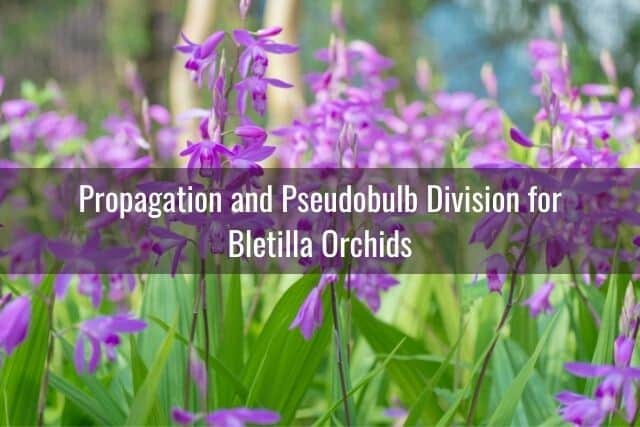
Spring is the growth season for this orchid. You will want to plant your Bletilla orchid in the early spring, after the last frost has occurred.
Bletilla orchids naturally spread out and produce pseudobulbs that grow just under the surface of the potting media.
These orchids can be propagated by pseudobulb division. The best time to propagate Betilla orchids is in the fall, after the flowers have fallen but before the leaves drop.
Once you’ve divided the pseudobulbs, you can replant them elsewhere, either in another area of your garden or in a pot. When dividing the orchid, make sure you have at least two or three pseudobulbs per division.
For more information, you can read more about propagating orchids, and go to the section about pseudobulb division for a step-by-step how-to guide. By dividing pseudobulbs, you can easily grow your orchid collection every year!
If you prefer not to manually divide the pseudobulbs, that is totally fine. Your Bletilla orchid will simply continue to grow and multiply, spreading out across your garden bed. It self-seeds, so each year you will find that your outdoor orchids are more plentiful than the previous year.
Final Thoughts
If you are curious about terrestrial orchids and want to add some to your orchid collection, Bletilla orchids are the way to go. They are considered to be among the easiest orchids to grow. They grow in the soil, can remain outdoors year round, provided temperatures don’t drop below freezing, and are relatively low-maintenance.
I would recommend this lovely orchid to any orchid grower, but especially beginner orchid growers looking to get their feet wet with an easy to care for outdoor orchid.
If you enjoyed this article, please pin it and share!
